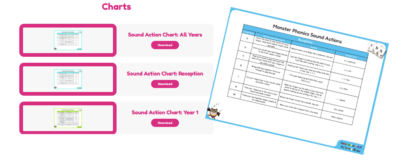The first step in teaching any systematic synthetic phonics programme, like Monster Phonics, is to teach the individual letter sounds. If these sounds are pronounced or articulated incorrectly, however, it can make the next step, blending for reading, much harder. It is crucial that time and effort is made to ensure children are pronouncing the sounds correctly using ‘pure’ sounds.
In phonics the pure sound is the pronunciation of each letter sound clearly and distinctly without adding additional sounds to the end. For example, the /m/ sound is pronounced as ‘m’ and not ‘muh,’ /g/ as ‘g’ not ‘guh.’ This is one of the most common mistakes that people make with phonics pronunciation. Consonant sounds are often pronounced with a ‘uh’ at the end. This is called a ‘schwa.’ For example, many people pronounce ’t’ as ‘tuh’ or ‘c’ as ‘cuh.’ By doing this you are producing two sounds instead of one: ‘t’ and ‘uh’ or ‘c’ and ‘uh.’
This can directly affect how children blend certain words. For example:
/c/ /a/ /t/ becomes ‘cuh’ + ‘a’ + ‘tuh’
The articulation of the additional sounds undoubtedly hinders children blending the sounds to read the word. Children who correctly pronounce the pure sounds for ‘c,’ ‘a’ and ‘t,’ however, will have no issues blending the word ‘cat.’ If children learn the pure sounds that letters make, they will become more proficient at blending to read much quicker and more easily.
